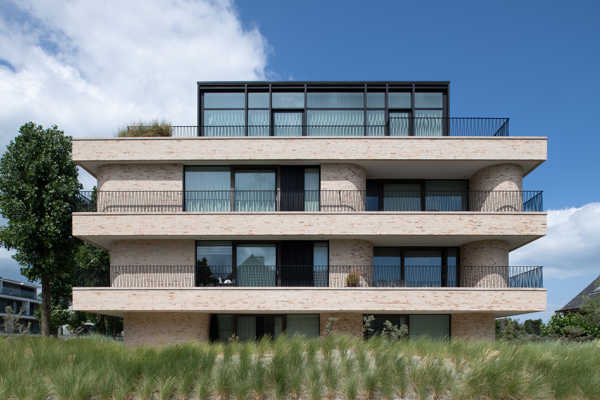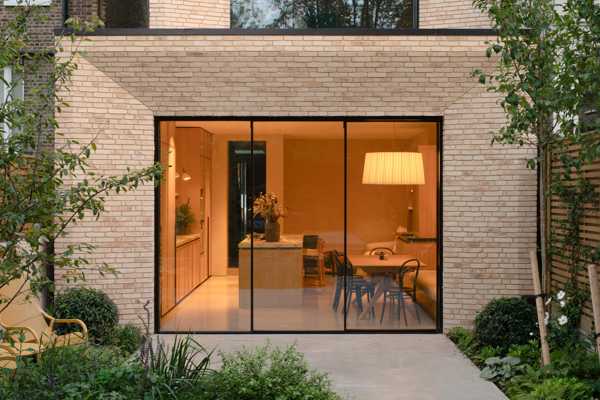Facing bricksBrick J
Technische informatie
- Kleur omschrijving
- The colour of the body is cream and nuanced from cream to ecru.
- Afmeting (L x B x H)
- ca. 227x74x55 mm (LxBxH)
- Aantal / m² met een traditionele voeg
- 63 (12 mm)
- Aantal / m² met een dunne voeg
- 71 (6 mm)
- Afmeting 2
- ca. 218x104x63 mm (LxBxH)
- Aantal / m² met een traditionele voeg
- 58 (12 mm)
- Aantal / m² met een dunne voeg
- 65 (6 mm)
Brick J
Cream ecological Waal format
Brick J is a cream (Basic cream pure) moulded brick produced using the Wasserstrich method. It carries both our Hand-Made label and the ECO-7-size label. Our Hand-Made label guarantees a strong, natural nuance. The unsanded Brick J also carries the ECO-7-size-label because it is 7 cm deep, unlike the classic Waal format which is 10 cm deep.
reportage Brick J

‘De Zuidkolk’ - Hooikade, Delft: vibrant architecture and sculptured space for nineteen spacious apartments with expansive views
Ecological brick ‘Nature7 Brick J’ with attractive blended look brings façade texture to life
The special place in the panoramic view of the Schie where Vermeer painted his View of Delft is now marked by the ‘De Zuidkolk’ building. The city may have changed but the view is still as exceptional as ever. Nineteen spacious apartments with expansive views and striking sculptural architecture now occupy this ‘postage stamp’ of a site.

‘Eileen Gray’ by Rietveld Projects is timeless minimalism in its most robust form
Nuanced cream-coloured brickwork defines solidity and creates interaction between horizontal and rounded forms
To call Rietveld Projects a project developer would actually be doing the company from Koksijde an injustice.

Frame House: a showcase for the Vande Moortel NATURE7 Brick J
An enhanced brick facade for a modern new build home in Victorian neighbourhood
Frame House by Studio AVC is an architectural triumph that masterfully blends modernity with the historical context of its surroundings. Nestled in a conservation area among Victorian properties, the project stands out for its innovative design choices, not least of which is its creative use of Vande Moortel NATURE7 Brick J—a material that significantly enhances both the aesthetic and structural aspects of the home.
Lees verder
Referenties
Verwerkingstips
Preparation of the construction site
- Always order the full amount of bricks required for a specific site. In this way, the entire order can be made during one production run.
- Try to have the full order supplied at one time. If this creates several deliveries, always mix a number of packs from the previous delivery with a number of packs from the new delivery. This procedure is especially recommended in case of re-order or for an additional order.
- Take bricks diagonally across the pack.
- Draw and use bricks from at least five different packs.
- For setting out, use bricks from the delivery made to the site in question. Do not exclusively use the theoretical dimensions of the brick, or samples previously supplied, or different production run from that intended for the site.
- As soon as the bricks arrive on site, check delivery tickets and certificates against the specification and order. Also check that there are no visible inconsistencies with the order.
- Do not lay bricks in freezing weather or protect the ‘fresh’ masonry with insulating mats in order to avoid frost damage to the mortar.
- In the case of prolonged dry hot weather, lightly dampen the newly laid brickwork to stop the mortar drying and curing too quickly.
- Do not lay bricks in precipitation in order to prevent mortar from running on the wall.
Avoid Efflorescence
- During and after laying, protect the newly built brickwork for a height of at least 60 cm - but ensure there is airspace between the brick face and the waterproof covering.
- Provisionally install rainwater down pipes to avoid saturation of the newly laid brickwork
- Never lay bricks in driving rain conditions
























